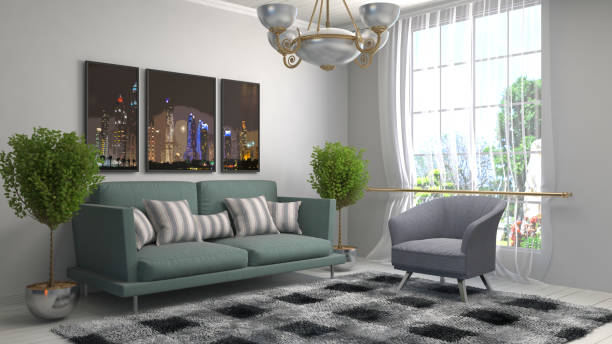It can be difficult to design a small living room with a modern update, as there is not enough space for you to install many things. Warm-colored walls and flooring tiles can create the illusion of more space in your living area. Consider using vitrified ceramic tiles for this purpose. Vitrified ceramic tiles are a great option for your living room. They offer style, durability, and quality.
Why use Vitrified Tiles
You can experiment with different designs and colors for the walls and floor of a small room. Vitrified Tiles offer a superior alternative to natural stones.
Here are some reasons why you should choose vitrified tiles for your small living room:
- Colour and design options that are stunning
- The perfect replica of natural materials
- Durable than wood and stone
- It is easier and cheaper to maintain compared to wood and stone
- Installation is easier and more affordable than with raw materials
- Easy to find in most regions
- The different surface finishes for wall and flooring tiles create style in any space.
- Recyclable and environmentally friendly
You can see the difference between natural stone and wood when you compare the designs, patterns, and finishes available in vitrified tiles.
Follow the steps below to get the best tiles for your living room now that you’re convinced of the benefits of using vitrified tiles.
Choose the type of vitrified tile.
The two most common forms of vitrified tiles include:
- Full body vitrified
- Double-charge vitrified tiles
- Glazed vitrified
The full-body vitrified tile has a uniform surface, unlike the glazed vitrified or double-charged tiles. So, chipping and breaking the tile anywhere will not change its color or appearance. These tiles have a similar appearance to natural stones, terracotta, and other types of tile.
Full-body vitrified tile (FBVT) may also be polished for a shiny surface. If you want a shiny floor, polished FBVTs would be a good choice. These tiles also have the most durable surfaces. You can therefore relax about your appearance. The cover is stain-free, and it lasts.
You don’t have to use double-charged vitrified tile (DCVT) for your living room, but you may want to consider the designs and colors. DCVTs can be more expensive and are best suited to areas with medium-to-high traffic, such as offices and shopping centers.
GVTs, or glazed vitrified tiles, are a great choice for their surface finish and designs. GVTs have surface designs that you would want to decorate your walls with. Here are some of the most popular designs from H&R Johnson in India, a ceramic tile producer with a history of six decades:
GVTs with a wood finish are one of the most common designs. Both wood planks and tiles are available for the walls and floor of your living room.
Plan a theme
You should plan your theme before you start building or replacing tiles in the living room. It is not necessary to follow the same article in the living room as in the other rooms. However, it should be the main theme for the entire house. Decide how you want your living room to be laid out and what items will go in it.
Decide if you want to use tiles only on the floor or also on the walls. The placement of tiles on the wall gives your living room a modern and unique look. You can create a focal wall using artistic tiles or vitrified 3D elevation tile.
Select Colours
Natural tones can help make small spaces appear bigger. The wood-like tiles will always be a popular choice for your living room’s floor. You can also mix and match glossy tiles with dual-toned settings. Living rooms often combine light-colored floors with walls painted in natural tones.
You can choose from a variety of options for walls, depending on your budget and preferences. You can use 3D elevation tiles to create an accent wall. You can also create a mural by using a large tile that has a unique pattern.
Choose the Right Size
The correct size of your tiles will ensure a smoother installation. Floor tiles are the most important to consider as they will cover an entire surface. The size of wall tiles is also important if you plan to tile the whole wall.
The ideal would be to minimize the amount of tiles that are wasted and cut for the installation. You should select a tile with a fractional size to ensure minimal cuts and adjustments. A 100-square-foot area, for example, would require tiles that are 60x60cm and 60x120cm. Tiles of 60x60cm or 60x120cm are suitable for an area of 100 sq.
The 20x60cm planks fit into almost any room but require expert grouting in order to stay put.
Choose tiles for walls vs. floors.
It is not necessary to purchase the same floor tiles as you do for your walls. The floor tiles must be able to withstand foot traffic and weight. They are usually thicker and costlier than wall tiles.
Wall tiles are lighter and can be made from a lower-density material than flooring tiles. The thickness of floor tiles from renowned brands is typically 8-10 mm. Wall tiles are usually 5-6 mm.
Elegant Living Rooms Using Vitrified Tiles
Vitrified tiles will solve the problem of a small living room. Vitrified tiles are a great option for giving your living room an elegant and modern appearance.
Vitrified tiles are a great way to replicate natural materials but with more features and a longer life span. GVT tiles come in a variety of patterns and designs that can add a unique look to any room. Find your unique strategy to transform your small living space into an elegant place with vitrified tiles.




